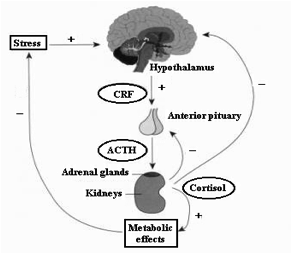A complex and important physiological pathway between brain and peripheral structures whereby the amount of steroids released from the adrenal glands is controlled by a negative feedback mechanism involving release of peptides from the anterior pituitary gland (adrenocorticotropic hormone, ACTH) and the hypothalamus (corticotrophin-releasing factor, CRF) as shown in the figure below. Peptide release is itself under control of the glucocorticoid receptors in the hippocampus. Receptor saturation diminishes peptide release and therefore adrenal activity. The reverse occurs when receptors are unsaturated.

Hypothalamic-pituitary-adrenal axis cells in the hypothalamus produce CRF in response to physical or psychological stress. CRF binds to cells in the anterior pituitary gland, which release ACTH that is transported to the adrenal glands. Here there is an increase in the secretion of cortisol (+), which triggers a series of metabolic effects in order to alleviate the influence of stress. It does so via negative feedback to the hypothalamus and the anterior pituitary gland (-). In turn, this decreases the concentration of ACTH and cortisol in the blood when the effects of stress decrease.
See Adrenal cortex, Adrenal glands, Corticotropin-releasing hormone (CRH), Cortisol, Feedback, Fetal programming, Glucocorticoids, Hippocampus, Hormones, Hypothalamus, Peptides, Pituitary gland, Steroids, Stress (or adrenal) hormones
